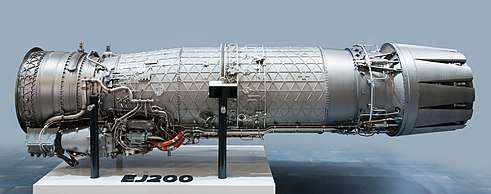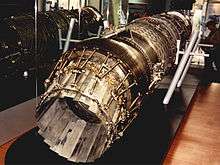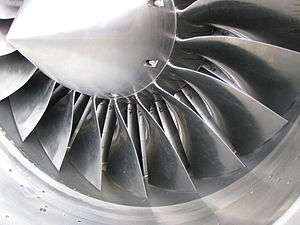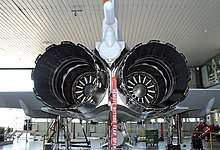Eurojet EJ200
The Eurojet EJ200 is a military low bypass turbofan used as the powerplant of the Eurofighter Typhoon. The engine is largely based on the Rolls-Royce XG-40 technology demonstrator which was developed in the 1980s. The EJ200 is built by the EuroJet Turbo GmbH consortium. The EJ200 is also used in the Bloodhound LSR supersonic land speed record attempting car.
| EJ200 | |
|---|---|
 | |
| EJ200 on static display | |
| Type | Turbofan |
| National origin | Multinational |
| Manufacturer | EuroJet Turbo GmbH |
| First run | 1991 |
| Major applications | Eurofighter Typhoon |

Development
Rolls-Royce XG-40
Rolls-Royce began development of the XG-40 technology demonstrator engine in 1984.[1] Development costs were met by the British government (85%) and Rolls-Royce.[2]
On 2 August 1985, Italy, West Germany and the UK agreed to go ahead with the Eurofighter. The announcement of this agreement confirmed that France had chosen not to proceed as a member of the project.[3] One issue was French insistence that the aircraft be powered by the SNECMA M88, in development at the same time as the XG-40.[4]
Eurojet EJ200
_(cropped).jpg)
The Eurojet consortium was formed in 1986 to co-ordinate and manage the project largely based on XG-40 technology. In common with the XG-40, the EJ200 has a three-stage fan with a high pressure ratio, five-stage low-aspect-ratio high-pressure (HP) compressor, a combustor using advanced cooling and thermal protection, and single-stage HP and LP turbines with powder metallurgy discs and single crystal blades. A reheat system (afterburner) provides thrust augmentation. The variable area final nozzle is a convergent-divergent design.
In December 2006, Eurojet completed deliveries of the 363 EJ200s for the Tranche 1 Eurofighters. Tranche 2 aircraft require 519 EJ200s.[5] As of December 2006, Eurojet was contracted to produce a total of 1,400 engines for the Eurofighter project.[6]
HAL Tejas

In 2009, Eurojet entered a bid, in competition with General Electric's F414, to supply a thrust vectoring variant of the EJ200 to power the HAL Tejas. After evaluation and acceptance of the technical offer provided by both Eurojet and GE Aviation, the commercial quotes were compared in detail and GE Aviation was declared as the lower bidder.[7][8]
TAI TFX
On 20 January 2015 ASELSAN of Turkey and Eurojet Turbo GmbH signed a Memorandum of Understanding to collaborate on the EJ200 military turbofan engine programme.[9][10] It is envisaged that the collaboration would produce a derivative of the EJ200 with thrust vectoring for use in Turkey's TFX 5th generation air superiority fighter programme. Eurojet EJ200 is not selected for TFX program. TFX will use General Electric F110 engine until indigenous manufactured by TRMOTOR.[11]
TAI Hürjet
Turkey's indigenous Jet training aircraft Hürjet will use "Typhoon"s EJ200 engine.A Letter of Intent was signed between Turkish Aerospace Industries (TAI) and Eurojet at the Le Bourget Aviation Show in Paris, France. TAI(TUSAŞ in Turkish) CEO Dr. Temel Kotil and Eurojet Ceo Clemens Linden on behalf of Eurojet consortium signed the letter. The Eufighter Typhoon aircraft is equipped with two engine engines but Hürjet will have one.The EJ200 has over 1 million hours of flight experience with two engines. Some minor changes will take place for the use of a single engine and it will be called a prototype until the engine is certified for single use.[12]
Landspeed record attempt
An EJ200 engine, together with a rocket engine, will power the Bloodhound LSR for an attempt at the land speed record. The target speed is at least 1000 mph.[13]
Variants
EJ2x0
Stage 1:
- The EJ2x0 with 20% growth compared to the original EJ200. The EJ2x0 engine will have dry thrust increasing to some 72 kN (or 16,200 lbf) with a reheated output of around 103 kN (or 23,100 lbf).[14]
Stage 2:
- The new engine plan to increase the output 30% more power compared to the original EJ200. The engine will have dry thrust of around 78 kN (or 17,500 lbf) with a reheated output of around 120 kN (or 27,000 lbf).[14]
Applications
Specifications (EJ200)


.jpg)
Data from Rolls-Royce plc[15]
General characteristics
- Type: Afterburning turbofan
- Length: 398.78 cm (157.00 in)
- Diameter: 73.66 cm (29.00 in)
- Dry weight: 988.83 kg (2,180.0 lb)
Components
- Compressor: Axial, 3-stage LP, 5-stage HP
- Combustors: Annular
- Turbine: 1-stage LP, 1-stage HP
Performance
- Maximum thrust: 60 kN (13,500 lbf) and 90 kN (20,200 lbf) (with afterburner)
- Overall pressure ratio: 26:1
- Bypass ratio: 0.4:1
- Air mass flow: 75–77 kg/s (9,900–10,200 lb/min)
- Turbine inlet temperature: 1,800 K (1,530 °C)
- Fuel consumption: 4,536–4,968 kg/h (10,000–10,950 lb/h) and 15,228–15,876 kg/h (33,570–35,000 lb/h) (with afterburner)
- Specific fuel consumption: 21–23 g/(kN⋅s) (0.74–0.81 lb/(lbf⋅h)) and 47–49 g/(kN⋅s) (1.66–1.73 lb/(lbf⋅h)) (with afterburner)
- Thrust-to-weight ratio: 6.11:1 and 9.17:1 (with afterburner)
See also
Comparable engines
Related lists
References
- Notes
- Donne, Michael (5 March 1984). "Rolls to develop engine for fighters". UK News. Financial Times. p. 8.
- "Rolls Readies Demonstrator Engine For European Fighter Aircraft". Advanced Fighter Technology. Aviation Week & Space Technology. Bristol, England: McGraw-Hill. 23 June 1986. p. 105.
- Lewis, Paul (3 August 1985). "3 European Countries Plan Jet Fighter Project". Business Day. The New York Times. The New York Times Company. p. 31.
- Donne, Michael (3 August 1985). "Why three into one will go; Europe's new combat aircraft". Financial Times. p. 6.
- "First Tranche II EJ200 Engine Delivered for Eurofighter Typhoon". defense-aerospace.com. Briganti et Associés. 16 July 2007.
- "EUROJET delivers all 363 Tranche 1 Engines to schedule" (PDF) (Press release). Eurojet GmbH. 22 December 2006. Archived from the original (PDF) on 28 September 2007.
- :: Bharat-Rakshak.com - Indian Military News Headlines :: Archived 11 October 2012 at the Wayback Machine
- "India picks GE's F414 for Tejas MkII fighter". Retrieved 3 October 2010.
- "Archived copy". Archived from the original on 25 January 2015. Retrieved 22 January 2015.CS1 maint: archived copy as title (link)
- http://www.defense-aerospace.com/article-view/release/160363/turkey-picks-ej200-engine-for-future-tfx-fighter-program.html
- https://www.defensenews.com/industry/2018/10/31/general-electric-beats-rolls-royce-to-power-turkeys-indigenous-fighter-jet/
- http://en.c4defence.com/Agenda/typhoon-engine-to-hurjet/8265/1
- "http://www.bloodhoundssc.com/fia-world-land-speed-record"
- "Archived copy". Archived from the original on 31 July 2010. Retrieved 13 September 2011.CS1 maint: archived copy as title (link)
- "Rolls-Royce EJ200 Engine Data Fact Sheet". Rolls-Royce plc.
- Footnotes
External links
| Wikimedia Commons has media related to Eurojet EJ200. |
- Eurojet GmbH
- Rolls-Royce EJ200
- EJ200 fact sheet
- EUROJET Offers its EJ200 Engine for the Tejas, Indian Light Combat Aircraft